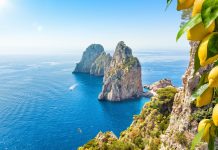Guide to the artistic sites
La Grotta Azzurra
IT: La Grotta Azzurra di Capri è nota in tutto il mondo per la sua vastità, la colorazione azzurra del suo interno e lo splendore bianco argenteo che assumono gli oggetti immersi nelle sue acque. L’ingresso della Grotta Azzurra è un piccolo varco nella parete rocciosa, largo circa 2 metri e alto altrettanto, che si trova sopraelevato sul livello del mare di circa 1 metro, per questo motivo per entrare bisogna distendersi sulla barca. L’ambiente interno appare tutto di colore azzurro. La colorazione azzurra della grotta è dovuta al fatto che la luce del giorno entra attraverso una finestra sottomarina che si apre esattamente sotto il varco d’ingresso, subendo in tal modo una filtrazione da parte dell’acqua, che assorbe il rosso e lascia passare l’azzurro. Un secondo fenomeno determina i riflessi argentei degli oggetti immersi: le bolle d’aria che aderiscono alla superficie esterna degli oggetti, avendo indice di rifrazione diverso da quello dell’acqua, permettono alla luce di uscire. Si pensa che l’interno della Grotta Azzurra in epoca romana, al tempo di Tiberio, fosse utilizzato come ninfeo marino. C’è stato anche chi l’ha immaginata come un luogo di Nereidi o di Sirene e chi riteneva fosse il regno di diavoli che intimorivano chiunque osasse entrarvi.
EN: Capri’s Blue Grotto is known throughout the world for its size, the intense blue tones of its interior and the magical silvery light which emanates from the objects immersed in its waters. The roof of the entrance is situated approximately 1 meter above the level of the sea and, for this reason, passengers are obliged to lie down in the boat whilst passing in to the cave. The interior is suffused with magnificent blue tones. The light is filtered by the water which absorbs the red tones, leaving only the blue ones to pass into the cave. A second phenomenon creates the silver appearance of the objects immersed in the water: given that the index of refraction of the bubbles of air which adhere to the surface of the objects is different to that of the water, the light is allowed to egress. It is believed that, in the Roman period, under the rule of Tiberius, the interior of the Grotta Azzurra was used as a marine nymphaeum. There have been those who imagined the cave as the habitat of Nereidi or of Sirens or believed it to be the realm of devils who bewitched all who dared to enter.
Monte Solaro e Cetrella
IT: La massiccia elevazione del Monte Solaro regala dalla sommità (589 m) una vista spettacolare sull’isola, sui Golfi di Napoli e Salerno e verso Ischia. Durante la discesa ci si imbatte nell’eremo di Cetrella, aggrappato a un balcone-belvedere naturale di roccia. Risale al XIV sec. fondato dai Certosini e poetico nell’isolamento e nell’armonioso gioco delle voltine. Pare debba il nome all’aromatica “erba cetra” (melissa): tutto il Solaro è scrigno delle più preziose rarità botaniche. Prima dell’eremo la casa dello scrittore C. Mackenzie è stata ristrutturata dagli “Amici di Cetrella”e trasformata in centro-studi su flora e fauna locali aperto ai visitatori (tel. 081.8371157) con biblioteca e giardino (piccola raccolta di specie tipiche).
EN: The imposing summit of Monte Solaro offers, at 589 metres, spectacular views over the whole island, the Bay of Naples, the Bay of Salerno and out towards Ischia. Coming back down you can take the detour to the hermitage of Cetrella, which we recommend. It dates back to the 14th century and was founded by Carthusian monks. There is poetry in the harmonious interplay of its vaults and in its splendid isolation. Its name apparently derives from the aromatic erba cetra (melissa); the mountain is a treasure trove of important botanical rarities. Before you get to the hermitage, you will come across what was once the house of the Scottish writer Compton Mackenzie. It has recently been restored by the Amici di Cetrella and is now a centre for the study of local flora and fauna, with a library and a garden containing a small collection of local species.
I Faraglioni
IT: Stella, Scopolo, faraglione di Mezzo, sono i nomi dei tre affascinanti spuntoni rocciosi, dalla mole imponente e dalle forme singolari, cartolina nota in tutto il mondo, che completano il panorama di Capri e si immergono nel mare blu più profondo.I faraglioni hanno sempre stimolato la fantasia e prodotto miti e leggende, tanto che anche Virgilio li citò nell’Eneide legandoli al mito delle Sirene. Il faraglione Stella è legato alla terraferma ed è caratterizzato da spettacolari spruzzi prodotti col mare mosso da una fessura subacquea vicina alla sua estremità, mentre quando il mare è calmo, questa stessa produce meravigliosi effetti cromatici con tonalità cangianti di azzurro. Lo Scopolo, invece, è singolare per la presenza della lucertola azzurra che vive solo lì. A completare il paesaggio, oltre alla particolare profondità del mare in quel punto, sono le correnti che rendono il mare particolarmente violento intorno ai faraglioni e li circondano di spruzzi e colori differenti quasi a renderli ancora più affascinanti e misteriosi.
EN: Carving their own niche in the skyline of Capri, sculpted by the wind and sea, and home to rare plants and wildlife, stand Stella (Star), Faraglione di Mezzo (in between) and Scopolo. These three rocky stacks, rising from the azure Tyrrhenian Sea, are collectively known as the Faraglioni. Backdrop to holiday snapshots and postcards over the world, in modern times, the Faraglioni have stimulated visitors and writers imagination throughout the ages as far back as antiquity, and were the setting for many myths. Stella, the stack still connected to the mainland, is known for its spectacular fans of spray from waves on choppy days. The windblown sea swirls into the Faraglione’s underwater hollow, before erupting, showering down onto the rocks. Quieter days at the Faraglioni are also charged with magical charm. Sunlight glancing on the surface of the water, mingles with light cast up from spaces in the rock below, creating fascinating shifting shades of iridescent blue around the rocks. Scopolo, the Faraglione furthest from land, is famous for its unique blue lizards, found nowhere else on Earth. The ultimate touch of mystique surrounding the Faraglioni is the relationship between the depth of the sea immediately surrounding the rocks, the strong currents flowing there, and the way the spray, splashing round the Faraglioni is shot through with light, creating an array of sparkling colors. Weather veiled in morning mist, surrounded in mystic colors and fine spray, or the splendors of sunset, the Faraglioni remain mysterious and fascinating.
La Piazzetta
IT: Sono in pochi a sapere che il vero nome del “Salotto del mondo”, la famosa Piazzetta di Capri, è Piazza Umberto I. Centro nevralgico di tutte le attività e degli interessi capresi, punto di riferimento per tutti coloro che amano la Capri mondana. Pochi sono i Vip, i politici e gli uomini dello spettacolo che non hanno sorseggiato un aperitivo, seduti all’ombra della caratteristica Torre dell’orologio, in uno dei quattro esclusivi bar.
EN: Only few people know that the real name of the so-called “Salotto del Mondo” (World’s Lounge), the famous Capri’s “Piazzetta”, is Umberto I Square. The crux of all Capri’s activities and interests; reference point for everyone who loves the worldly aspect of Capri. Very few V.I.P., politicians and showmen have not ever had an appetizer sitting in the shade of the characteristic ” Torre dell’Orologio” (The Clock Tower), in one of the four bars there.
I Giardini di Augusto e Via Krupp
IT: I Giardini di Augusto sono un esempio d’organizzazione botanica in stile caprese, associano la presenza di fiori e piante dell’isola di Capri ad una cornice di panorami mozzafiato. La creazione dei Giardini di Augusto risale agli anni Trenta quando furono create le terrazze, presenti ancora oggi, su cui sono strutturati. Via Krupp è una strada pedonale che collega la zona della Certosa di San Giacomo e dei Giardini di Augusto con Marina Piccola. Costruita nei primi anni del 1900, è stata voluta da Friedrich Alfred Krupp, un industriale tedesco. Via Krupp fu progettata e realizzata dall’ingegner Emilio Mayer tagliando la roccia viva fino al mare, con un percorso a tornanti così stretti da sembrare sovrapposti. Guardandola dall’alto o percorrendola, regala un effetto così strabiliante da poterla ritenere una vera e propria opera d’arte, addolcita dalla vegetazione tipicamente mediterranea che spontaneamente vi cresce.
EN: The Gardens of Augustus are a fine example of Capri’s botanical ornamentation, with the flowers and plants of Capri being used to form an ornate picture frame for the island’s breathtaking panoramas. The creation the Gardens of Augustus dates back to the nineteen thirties when the terraces on which the gardens still lie were constructed. Via Krupp connects the area of the Charterhouse of San Giacomo and the Gardens of Augustus with Marina Piccola. Commissioned by the German industrialist, Friedrich Alfred Krupp, the pathway was built in the early 1900’s, Via Krupp was designed and realized by the engineer Emilio Mayer, who cut through the rock until the sea, creating a series hairpin bends set so close together they appear almost to overlap. Observing the path from on high or walking along the winding route, one is inevitably struck by such an incredible feat of engineering and artistic genius, made all the more captivating by the typically Mediterranean vegetation which spontaneously grows along the path.
Marina Grande
IT: Nel 1862, allo scrittore francese Maxime Du Camp, Marina Grande apparve come “…un’esigua spiaggia cosparsa di ciottoli e ingombra di barche tirate a secco, una fila di case dal tetto piatto allineate di fronte al mare…”. Mancando il porto, le persone che arrivavano erano costrette a scendere sull’arenile, portate a cavalcioni dai marinai. Solo nel 1876 fu costruito un rudimentale pontile ed occorrerà attendere il 1928 per la costruzione di una prima banchina destinata alle operazioni di sbarco e di imbarco.
EN: In 1862, French writer Maxime Du Camp saw Marina Grande as “…a tiny pebble beach cluttered with boats drawn out of the water, a row of flatroofed houses facing the sea…”. As there was no harbour, people arriving had to disembark directly onto the shore astride the sailors. Only in 1876 was a primitive landing-stage built and it was not until 1928 that the first wharf designed for embarking and disembarking operations was built.
Marina Piccola
IT: È l’approdo meridionale dell’isola, situato in una pittoresca insenatura ai piedi dei dirupi del Monte Solaro. Fino alla fine dell’Ottocento comprendeva un piccolo gruppo di case di pescatori sovrastanti due spiaggette di ghiaia nei pressi di un antico approdo di origine romana e il famoso Scoglio delle Sirene, dedicato dalla voce popolare alle mitiche incantatrici. Agli inizi del Novecento, la località fu ritratta da molti artisti stranieri i cui quadri sono esposti nei musei più famosi.
EN: This is the island’s southern landing place, set in a picturesque inlet at the foot of Mount Solaro. Until the late 19th century it consisted of a small group of fishermen’s houses overlooking two small pebble beaches close to an ancient landing place of Roman origin and the famous “Scoglio delle Sirene”, dedicated to the popular belief in the mythical enchantresses. At the beginning of the 20th century, this spot was painting by many foreign artists, whose pictures are on display in museums all over the world.
Villa Jovis
IT: É una delle più importanti dimore costruite dall’Imperatore Tiberio durante la sua permanenza a Capri. Riportata alla luce attorno al ‘700 da Carlo di Borbone, Tiberio preferiva rifugiarsi qui, lontano dallo stress di Roma, immerso nel verde e circondato da magnifici scenari. Dalla villa,infatti, si può godere di un magnifico panorama che spazia dalla penisola sorrentino-amalfitana, alla Punta Campanella, agli scogli dei Li Galli e alla baia di Jeranto. Oggi, purtroppo, la maestosa costruzione si presenta per la maggior parte distrutta. Gli unici vani individuabili con una certa facilità sono quelli delle cisterne, che costituiscono il nucleo fondamentale del complesso. Queste venivano usate per l’approvvigionamento idrico. Nella parte settentrionale del complesso si trova lo strapiombo denominato “Salto di Tiberio”(297m). Esso era il luogo da cui l’Imperatore, secondo alcune leggende, lanciava le sue vittime, in seguito a sevizie e torture.
EN: Certainly it is the most important tiberian villa; it was discovered about the eighteenth century by Carlo of Borbone and it includes an enough vast area. Tiberius preferred take shelter here, far from Rome stresses plunged in the nature and surrounded by wonderful landscapes that made Villa Jovis one of the most important monuments of Capri. From the villa, in fact, we can enjoy a wonderful view that shows the peninsula of Sorrento-Amalfi, cape Campanella, Li Galli reef and the Jeranto Bay. Today, unfortunately, the stately building is for the major part destroyed. The rooms identified with a certain easiness are only those of the tanks that constitute the fundamental complex nucleus. These tanks were used for the water supplying. On the northern side of the complex there is the overhang called salto di Tiberio (Tiberius jump) (297 m). It was the site from which Tiberius, according to some legends, threw to the sea his victims after several torments and torture.
La Certosa di San Giacomo
IT: La Certosa di San Giacomo a Capri fu fondata come un monastero Certosino fra il 1371 e il 1374 dal Conte Giacomo Arcucci, nobiluomo di Capri, Gran Ciambellano e Segretario di Giovanna I di Anjou, Regina di Napoli. La Certosa fu costruita nella valle tra le colline di Castiglione e di Tuoro, in un luogo da cui si gode la vista del mare e dei Faraglioni, come segno di ringraziamento per la nascita del primogenito della moglie del Conte, Margherita Sanseverina. La Certosa godette del patronato reale della Regina Giovanna, che la dotò di terreni, doni e privilegi ecclesiastici. Oggi la Certosa di San Giacomo è demanio statale, proprietà dello Stato italiano sotto la supervisione della Soprintendenza Speciale per il Patrimonio Storico, Artistico, Etnoantropologico e per il Polo Museale della Città di Napoli, da cui dipendono anche la Certosa di San Martino e il Museo di Capodimonte di Napoli. Da quando non è più un monastero funzionante, la Certosa è sede di una biblioteca, un museo e una scuola ed ospita anche numerosi eventi culturali e musicali come il Festival Internazionale delle Arti messo su ogni estate dagli Amici della Certosa.
EN: The Certosa di San Giacomo in Capri was founded as a Carthusian monastery between 1371 and 1374 by Count Giacomo Arcucci, nobleman of Capri, Grand Chamberlain and Secretary to Joanna I of Anjou, Queen of Naples. Built in the valley between the Castiglione and Tuoro hills on a site overlooking the sea and the Faraglioni rocks, it was dedicated as a thanksgiving for the first born of the Count’s wife Margherita Sanseverina and enjoyed the royal patronage of Queen Joanna, who endowed it with lands, gifts and ecclesiastical privileges. Today, the Certosa di San Giacomo is demanio statale, property of the Italian State under the supervision of the Soprintendenza Speciale per il Patrimonio Storico, Artistico, Etnoantropologico e per il Polo Museale della città di Napoli, which also oversees the Certosa di San Martino and the Capodimonte Museum in Naples. No longer a working monastery, it houses a library, museum and school and hosts a variety of musical and cultural events including the International Arts Festival mounted each summer by the Friends.
Centro storico di Anacapri
IT: Se la Piazzetta di Capri è il cuore mondano dell’isola, punto di riferimento per lo struscio pomeridiano e l’aperitivo serale ai tavolini dei bar, il centro storico di Anacapri è il luogo dove è ancora possibile passeggiare con calma tra silenziose piazze e stradine colorate dai gerani e dalle bouganville.
EN: If the Piazzetta of Capri is the unrivalled focus of the island’s glamorous social life, filled with elegant pavement cafes where the world’s beautiful people habitually come to strike a pose, the pretty historic center of Anacapri is the exact opposite: where even the most famous of visitors can pass blissfully unobserved as they saunter through the town’s peaceful piazzas and bougainvillea and geranium festooned lanes.
La Casa Rossa
IT: Fino al 1899 la Casa Rossa fu l’abitazione del colonnello americano John Clay H. MacKowen, giunto in Italia subito dopo la guerra civile americana. MacKowen seguì l’esempio di Axel Munthe e impreziosì la sua villa con i reperti archeologici che recuperava durante le sue passeggiate tra i sentieri di Capri, trasformando la sua casa caprese in un vero e proprio centro culturale. Nelle sale della Casa Rossa è possibile ammirare la mostra permanente “L’Isola dipinta: viaggio pittorico a Capri ed Anacapri tra Ottocento e Novecento”, un’esposizione di tele firmate da importanti artisti come Barret, Carelli, De Montalant, Carabain, Lovatti, Hay, Casciaro, Vianelli. Nei quadri sono raffigurati antichi sentieri, luoghi, panorami e attimi di vita quotidiana a Capri tra il XIX e il XX secolo.
EN: Until 1899 the Casa Rossa was the residence of the American colonel, John Clay H.MacKowen, who came to Italy in the immediate aftermath of the American Civil war. MacKowen followed the example of the Swedish physician Axel Munthe: filling his island home with the archeological finds which he collected during his walks along the pathways of Capri. In the rooms of the Casa Rossa today’s visitors can see the permanent exhibition “The Painted Island: pictorial journey in Capri and Anacapri between the 19th and 20th century”, featuring works by important artists such as Barret, Carelli, De Montalant, Carabain, Lovatti, Hay, Casciaro, and Vianelli. In addition to a number of impressive land and seascapes, the paintings offer a fascinating record of everyday life on the island of Capri between the 1800’s and 1900’s.
La Chiesa di San Michele
IT: Pochi passi dopo la Casa Rossa una traversa permette di raggiungere Piazza San Nicola e la Chiesa di San Michele Arcangelo. Questa costruzione barocca, costruita tra il XVII e il XVIII secolo insieme al limitrofo complesso delle Teresiane, è una delle principali attrazioni turistiche dell’isola grazie allo splendido pavimento in maiolica raffigurante la cacciata di Adamo ed Eva dal Paradiso Terrestre. La chiesa di San Michele Arcangelo nasce da un progetto dell’architetto Antonio Domenico Vaccaro e il pavimento è opera del maestro napoletano Leonardo Chiaiese.
EN: Only a few steps after the Casa Rossa, to the right, visitors enter the Piazza San Nicola, home to the Church of San Michele Arcangelo. This baroque construction, built between the 17th and 18th century together with the nearby Theresian complex, is one of the island’s most important tourist attractions, thanks to its splendid pavement in majolica, depicting the expulsion of Adam and Eve from Eden. The Church of San Michele Arcangelo was designed by the architect Antonio Domenico Vaccaro. The pavement was realized by the Neapolitan master Leonardo Chiaiese.















